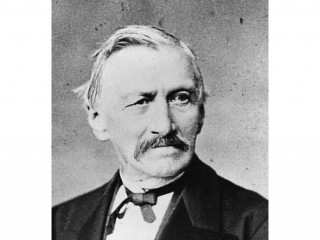
Gottfried Semper biography
Date of birth : 1803-11-29
Date of death : 1879-05-15
Birthplace : Mecklenburg, Germany
Nationality : German
Category : Arhitecture and Engineering
Last modified : 2012-01-24
Credited as : architect, art critic, professor of architecture
0 votes so far
Semper wrote extensively about the origins of architecture, especially in his book The Four Elements of Architecture from 1851, and he was one of the major figures in the controversy surrounding the polychrome architectural style of ancient Greece. Semper designed works at all scales, from a baton for Richard Wagner to major urban interventions like the re-design of the Ringstraße in Vienna.
Certain civic structures remain today, such as the Elbe-facing gallery of the Zwinger Palace complex. His first building for the Dresden Hoftheater burnt down, and the second, today called the Semperoper, was built in 1841. Other buildings also remain indelibly attached to his name, such as the Maternity Hospital, the Synagogue (destroyed during the Third Reich), the Oppenheim Palace, and the Villa Rosa built for the banker Martin Wilhelm Oppenheim. This last construction stands as a prototype of German villa architecture.
On September 1, 1835 Semper married Bertha Thimmig. The marriage ultimately produced six children.
A convinced Republican, Semper took a leading role, along with his friend Richard Wagner, in the May 1849 uprising which swept over the city . He was a member of the Civic Guard (Kommunalgarde) and helped to erect barricades in the streets. When the rebellion collapsed, Semper was considered a leading agitator for democratic change and a ringleader against government authority and he was forced to flee the city.
He was destined never to return to the city that would, ironically, become most associated with his architectural (and political) legacy. The Saxon government maintained a warrant for his arrest until 1863. When the Semper-designed Hoftheater burnt down in 1869, King John, on the urging of the citizenry, commissioned Semper to build a new one. Semper produced the plans, but left the actual construction to his son, Manfred.
After stays in Zwickau, Hof, Karlsruhe and Strasbourg, Semper eventually ended up back in Paris, like many other disillusioned Republicans from the 1848 Revolutions (such as Heinrich Heine and Ludwig Börne). In the fall of 1850, he travelled to London, England. But while he was able to pick up occasional contracts — including participation in the design of the funeral carriage for the Duke of Wellington and the designs of the Canadian, Danish, Swedish, and Ottoman sections of the 1851 Exhibition in the Crystal Palace — he found no steady employment. If his stay in London was disappointing professionally, however, it proved a fertile period for Semper's theoretical, creative and academic development. He published Die vier Elemente der Baukunst (The Four Elements of Architecture) in 1851 and Wissenschaft, Industrie und Kunst (Science, Industry and Art) in 1852. These works would ultimately provide the groundwork for his most widely regarded publication, Der Stil in den technischen und tektonischen Künsten oder Praktische Ästhetik, which was published in two volumes in 1861 and 1863.
In 1855 Semper became a professor of architecture at the new school and the success of many of his students who attained success and renown served to ensure his international fame. The Swiss architect Emil Schmid was one such student. With his income as a professor, Semper was able to reunite his family, bringing them to Zurich from Saxony. The City Hall in Winterthur is among other buildings designed by Semper in Switzerland.
Semper provided Bavaria's King Ludwig II with a conceptual design for a theatre dedicated to the work of Richard Wagner to be built in Munich. The project, developed from 1864 to 1866, was never realized, although Wagner 'borrowed' many of its features for his own later theatre at Bayreuth.
To be completed The 'Museum-question' was discussed in Vienna during the 1860s. Works forming the imperial art collection were scattered among several buildings. Semper was assigned to submit a proposal for locating new buildings in conjunction with redevelopment of the Ringstrasse. In 1869 he designed a gigantic 'Imperial Forum' which was not realized. The National Museum of Art History and the National Museum of Natural History were erected, however, opposite the Palace according to his plan, as was the Burgtheater.
In 1871 Semper moved to Vienna to undertake the projects. During construction, repeated disagreements with his appointed associate architect (Karl Freiherr von Hasenauer), led Semper to resign from the project in 1876. In the following year his health began to deteriorate. He died two years later while on a visit to Italy.
















